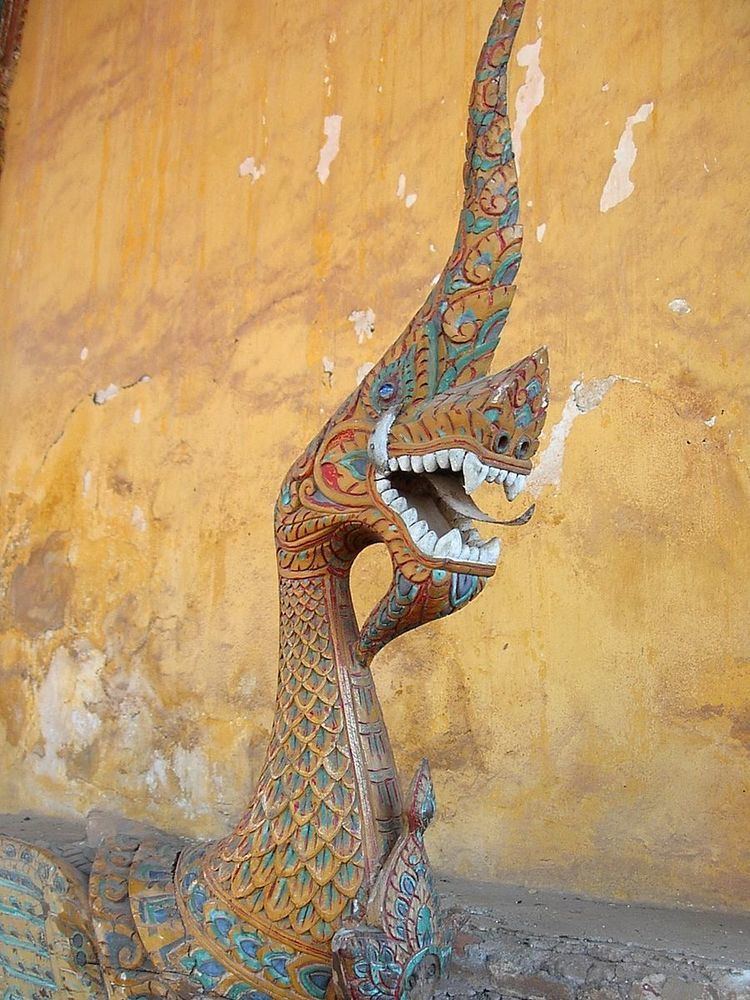Grouping Mythology | Similar creatures Dragon, Pakhangba | |
 | ||
Sub grouping Mythological hybrids
Buddhist mythology Mythology Laos, Thailand and Cambodia Habitat Rivers, sacred ponds, lakes, caves. | ||
The Phaya Naga (Thai: พญานาค; rtgs: phaya nak; literally: lord of nāga) are nāga, mythical serpent-like creatures, believed by locals to live in the Mekong river or estuaries. Common explanations of their sightings have been attributed to oarfish, elongated fish with red crests; however, these are exclusively marine and usually live at great depths. People in both Laos and Thailand attribute the naga fireballs phenomenon to these creatures.
Contents
Folklore
Thai and Lao folklore holds the Phaya Naga to be semi-divine, demi-creatures, which possess supernatural powers as has been described in Buddhist and Hindu cosmology. The "Kamchanod Forest" (ป่าคำชะโนด; rtgs: pha kamchanod) Ban Dung District, Udon Thani province, which is held in high reverence and fear across Thailand, is believed to be the border between the human world and the netherworld, and is frequently depicted in Thai folklore as the site of many hauntings, but more frequently is considered to be the home of the Naga.
In Tai Yai folklore of Nanzhao Kingdom (now southern China and Southeast Asia during the 8th and 9th centuries, which was centered on present-day Yunnan in China.) believed Erhai lake is inhabited of Naga and is the creator of the Mekong.
Appearance
Many people, particularly in Isan (northeastern region of Thailand), believe that the Naga are responsible for unnatural wave phenomena occurring in the rivers or lakes in the vicinity. It is also frequently claimed that the serpent-like demigods are responsible for marks on common objects, such as car hoods or house walls.
A police office has also claimed to be in contact with the Naga, although the implications of this contact is not thoroughly explained.
In attempts to explain these phenomena scientists and researchers at the Faculty of Science of Chulalongkorn University have attributed these seemingly preternatural phenomena to standing waves in water, and posit that the existence of Phaya Naga is similar to belief in Loch Ness Monster in Scotland or Ogopogo in Canada, and further maintain that the serpent-like tracks of the Phaya Naga are very possibly forged by humans.
History
Lao mythology maintains that the Naga are the protectors of Vientiane, and by extension, the Lao state. The Naga association was most clearly articulated during and immediately after the reign of Anouvong. An important poem from this period San Lup Bo Sun (or San Leupphasun Lao: ສານລຶພສູນ) discusses relations between Laos and Siam in a veiled manner, using the Naga and the Garuda, to represent Laos and Siam, respectively. The Naga is incorporated extensively into Lao iconography, and features prominently in Lao culture throughout the length of the country, not only in Vientiane.
Popular culture
Many Lakorn (Thai television soap opera) are based on a Phaya Naga legend, such as Poot Mae Nam Khong (ภูติแม่น้ำโขง) in 2008, Manisawat (มณีสวาท) in 2013 or Nakee (นาคี) in 2016.
A search for the Phya Naga was recently featured in a Destination Truth episode on the SyFy (formerly Sci-Fi Channel) series in Series 01 (episode 02).
